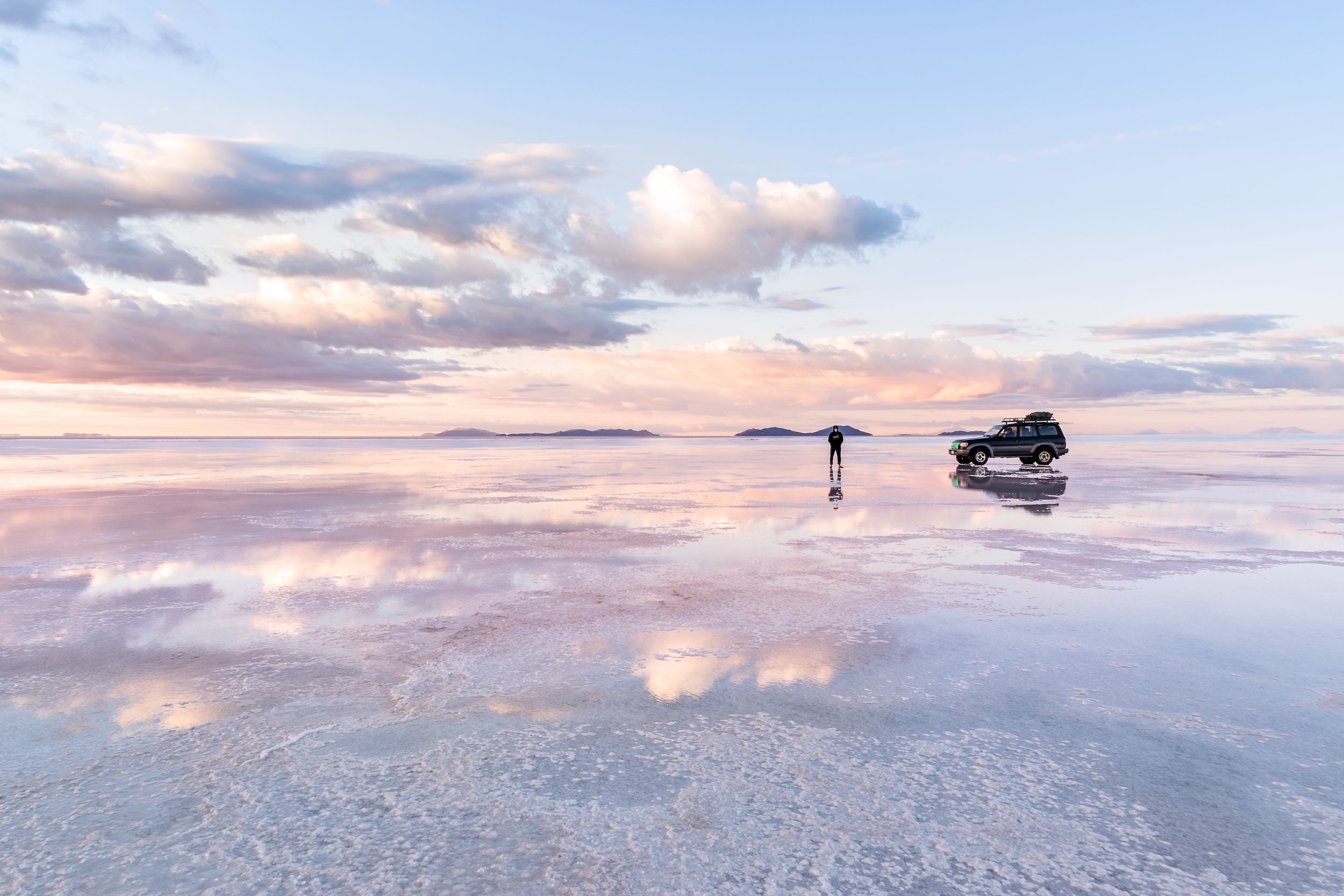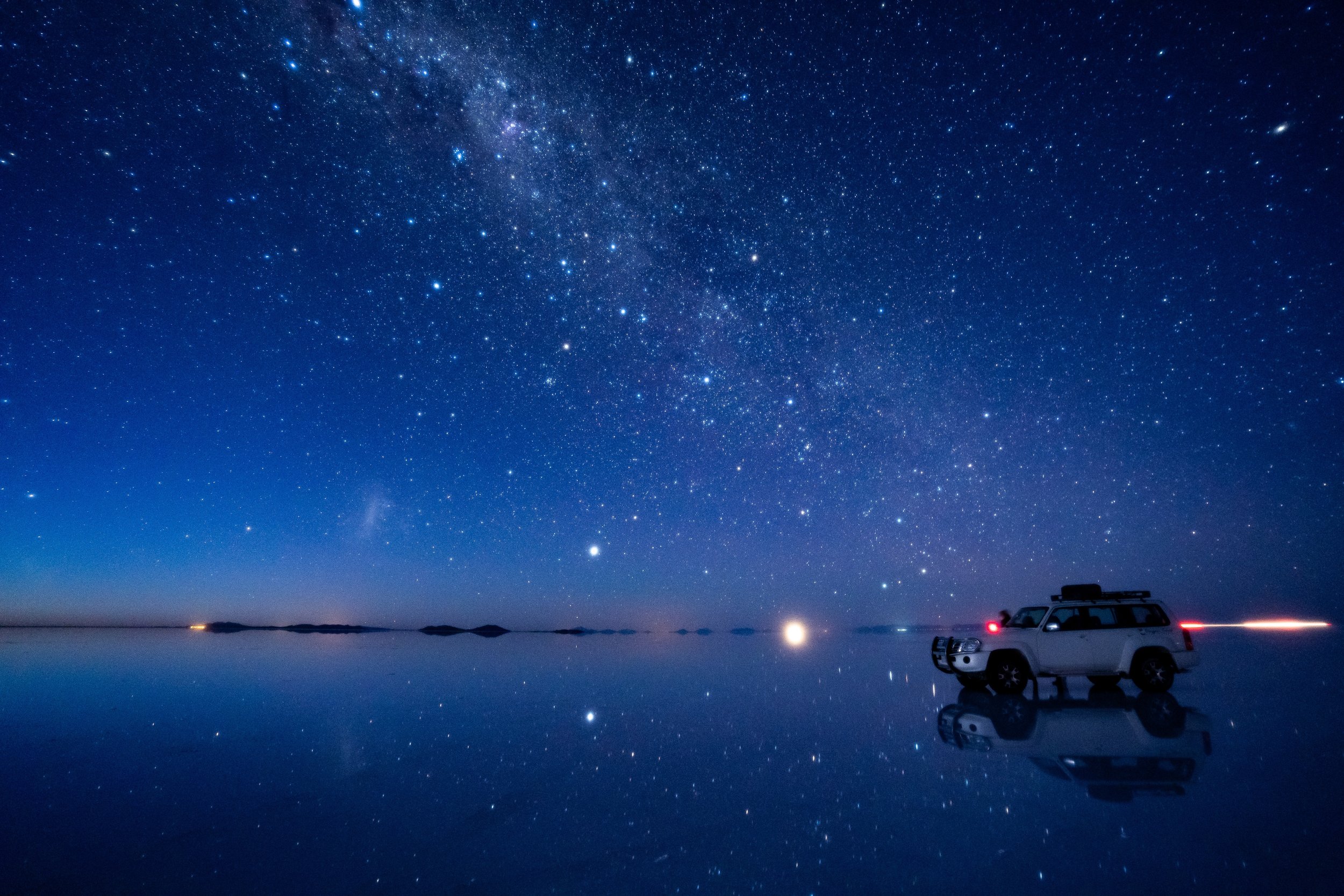
DESERTS AND THE DARK
When I signed up to go to Antarctica back in 2020, I also planned to travel through South America. I spent three years (and counting!) learning Spanish so I could communicate while I was on the road. Some of the places I wanted to see were Chile’s Atacama Desert and the Salar de Uyuni in Bolivia. Both are world-renowned for their dark skies and astrophotography opportunities. If you go at the right time, which this workshop aims to do, the beautiful reflections on the salt flats are also visible. I travelled overland from Chile into Bolivia with fellow adventurers, and we had a fantastic time. I knew that I wanted to put a workshop together in this part of the world, so it was both a fun-and-fact finding mission. With the assistance of a travel agent in San Pedro, I’ve put together what I think is an incredible opportunity to travel and see this part of the world while learning how to photograph the night skies.
SALAR DE UYUNI: A COSMIC MIRROR
Starting in Bolivia, you'll discover the mesmerizing Salar de Uyuni, the world's largest salt flat. This vast expanse of salt, stretching as far as the eye can see (and visible from space!), provides a unique canvas for capturing otherworldly astrophotography.
The Reflective Skies
During the rainy season, the salt flat transforms into a gigantic mirror, perfectly reflecting the vastness of the sky above. This gives you a once-in-a-lifetime opportunity to capture images that blur the line between heaven and earth.
Light Painting on the Salt Flats
Salar de Uyuni's flat surface offers an excellent opportunity for creative astrophotography and other techniques such as light painting. Illuminating salt crystals or incorporating props into your shots can add a sense of play to your images.
SAN PEDRO DE ATACAMA: GATEWAY TO THE STARS
Crossing the border into Chile, nestled in the heart of the Atacama Desert, San Pedro de Atacama is an astronomer's playground. Its remote location and clear, unpolluted skies make it an idyllic spot to capture the awe-inspiring beauty of the universe.
Capturing the Milky Way
In San Pedro de Atacama, the Milky Way arches above the desert landscape and the stars are never-ending. This will allow you to capture stunning images of the universe above. As the sun sets in the Valle de la Luna (Moon Valley), with its unique rock formations and the distant Andes Mountains, you might even put the camera down so you can take it all in.
Unveiling the Stars with Nighttime Landscapes
San Pedro de Atacama offers much more than just the Milky Way. Its high altitude, dry climate, and minimal light pollution allow for unique views of constellations, shooting stars, and Magellanic Clouds.
This immersive experience promises to be a game-changer for any photographers seeking to enhance their skills and unleash their creative potential. As an advocate for photography and storytelling, I eagerly assist participants in utilizing the power of their cameras to communicate compelling narratives. Throughout the expedition, I offer my knowledge and expertise to transform your photography from ordinary to extraordinary. From composition and lighting to post-processing techniques, I aim to ensure you capture breathtaking images that leave lasting impressions. Beyond technical skills, we will explore storytelling, helping you make deeper connections with your audience.
Join me on an adventure that will transform your photography and help create lasting memories and connections with fellow photographers. Don't miss an opportunity to make a lasting impact with your art!
TRIP DATES
February 23 - March 4, 2025
LOCATION
Salar de Uyuni, Bolivia to
San Pedro de Atacama, Chile
COST
$7800 Canadian Dollars
GROUP SIZE
Minimum 3
Maximum 12
DIFFICULTY
Easy hiking and walking
ITINERARY
Day 1 - February 23
Welcome to La Paz! Today is a day for rest, altitude acclimation, and the opportunity to meet and greet your fellow expedition participants. The day is yours to do as you please, but there will be a group welcome dinner in the evening. This will be an early night as we will have to be up early the following day.
Welcome dinner included
Day 2 - February 24
The workshop starts with an early morning flight from La Paz to Uyuni. Upon landing, we will check into our accommodations and have a brief orientation. We will visit the Cemetario de Trenes (train cemetery) on the outskirts of Uyuni for sunset and into the night for astrophotography. It is a perfect playground for capturing some unique images of these rusted giants of the rails with the Milky Way and stars overhead.
Breakfast, lunch, and dinner included
Day 3 - February 25
We will be picked up in Uyuni and dropped off at our luxury salt hotel on the Salar de Uyuni which is a perfect place to stage our excursions into the Salar. Here we will visit the salt flats for sunset and into the night for amazing astrophotography experiences.
Breakfast, lunch, and dinner included
Day 4 - February 26
We start our day on the Salar for sunrise (assuming you even chose to sleep the night before!) and also explore other areas around the flats, such as Isla Incahuasi, Plaza de las Banderas, Uyuni Salt Lake, Colchani village for the Salt Museum and handicrafts, etc. You may also choose to enjoy some downtime and rest at the hotel during the day. We will head back to the salt flat for sunset and more astrophotography.
Breakfast, lunch, and dinner included
Day 5 - February 27
Another early morning for sunrise on the salt flats with an opportunity to visit any sights missed the day before or revisit any that we enjoyed. If we haven’t had fun with forced-perspective images yet, today’s the day, as this will be our last full day on the flats. We will spend our last night on the Salar with another sunset and astrophotography session. We’ll possibly switch hotels today, venturing further into the Salar, which will allow us to spend less time in the vehicle the following day.
Breakfast, lunch, and dinner included
Day 6 - February 28
We depart the Salar today and head to Villa Mar for the night. There will be many photo opportunities along the way, but consider this more of a “travel day.” Sites encountered on the way - Sora Wetland, Cañon de Alota (Anaconda Canyon), Laguna Negra (Black Lagoon), Lost Italia and Valley of the Rocks. A reminder that accommodations this evening will be very humble.
Breakfast, lunch, and dinner included
Day 7 - March 1
Another early start to visit sites such as Laguna Colorada, a high-altitude salt lake, home to three of the world’s six flamingo species and known for its reddish hue due to the algae present in the water. Desierto Salvador Dalí (Salvidor Dali Desert), Sol de Mañana geysers, take a dip in the Polques Hot Springs, Laguna Verde, and more!
This is a busy day with many stops as we work our way to the Chilean border. The border closes at 1600 so we will need to make sure we get through on time. We will end our night at our hotel in San Pedro de Atacama, Chile. No events or excursions will be scheduled for this evening so we can all enjoy some time off the road and out of the vehicles.
Breakfast, lunch included, dinner included
Day 8 - March 2
A free day for exploring San Pedro, doing laundry, catching up on editing, etc. In the afternoon, we will be taken by shuttle to Valle de la Luna for sunset where we will enjoy snacks and cocktails. We will finish the evening with astrophotography.
Breakfast included, sundowner of snacks and drinks
Day 9 - March 3
Another free day to catch up on sleep or whatever else you might wish to do. We will meet again late afternoon to be shuttled to a location that should be a little more tourist-free (no guarantees of course!) for our final night together under the stars.
Breakfast included, sundowner of snacks and drinks
Day 10 - March 4
The expedition is officially over! Depending on your travel schedule and itinerary, you may choose to return to Uyuni in order to get to La Paz or other parts of Bolivia or continue touring through Chile. There are many options for travel back to Uyuni, but it will be your responsibility to make departure bookings depending on your route.
Breakfast included
SUBJECT TO CHANGE
We are travelling during the rainy season (December to March), and as such, the itinerary may need to be modified. For example, the salt flat is flooded, and some areas (Incahuasi Island) may not be accessible. The flooded areas change constantly, so depending on the situation at that time, the driver will offer the best alternative for our tour.
Three days overland from San Pedro to Uyuni.
What’s Included
all photo instruction
airfare from La Paz to Uyuni
all accommodations
all breakfasts as well as five lunches and six dinners. San Pedro has amazing culinary options and I can happily make some recommendations
all park permit and entrance fees
all ground transportation during the expedition
snacks and a cocktail when on our photo excursions in San Pedro
What’s Not Included
international flights/travel to La Paz
vaccinations, medications, or COVID-related testing
visa and/or passport fees
travel insurance (mandatory)
alcoholic beverages
gratuities for drivers, guides, and service staff
any delays due to weather, and any extensions as a result
return travel to Uyuni/La Paz or to another destination upon conclusion of the workshop
Taking “I’ll pack you in my luggage” seriously.
Tour of one of the salt hotels I stayed at.
Fun with forced perspective on the Salar.
Preparation and Tips
Here are a few tips to make the most out of your astrophotography adventure:
1. Gear: A camera, lenses, and sturdy tripod. Lots of memory cards and extra batteries. A toy dinosaur or other toy for a prop for forced perspective images on the Salar.
2. Clothing: Pack warm clothing as temperatures can get cold and drop significantly during the night in high-altitude regions.
3. Planning: Most of this is done for you already, as we will be here during the few days before, during, and after the new moon, which will give us the darkest skies possible. It is also the time of year when the salt flats should have a layer of reflective water.
4. Protect your equipment: Be mindful of these regions' dry, dusty conditions. Use lens hoods and protective covers for your camera gear to prevent damage.
5. Safety: None of the areas we are going to are considered unsafe, but you should always remain vigilant and aware of your surroundings, especially in the bigger towns and cities.
6. Altitude warning: We will be in areas of up to 5000 meters in elevation. If you haven’t properly acclimated to the altitude, you may experience symptoms of altitude sickness. These can either be mild or very severe. Symptoms do dissipate after a few days. Even if you think you’re not going to be impacted, it can happen fast and without warning. Speak to your doctor about getting altitude sickness pills or other forms of preventative measures.
Also be aware that because the air is thinner at higher altitudes, low-impact everyday activities such as walking, etc can be hard on the lungs. There’s no need to exert yourself more than necessary.
Insurance Policy
All participants must have trip cancellation/interruption insurance, as well as any medical or emergency rescue coverage. Proof of insurance is required a month prior to the start date of the expedition. Please refer to the FAQ for a list of what is required from your insurance policy.
Cancellation Policy and Payment Plan
Unexpected circumstances can arise, causing the need for cancellations. While the deposit is non-refundable, it is transferable to another person. With this policy, if you are unable to attend, you have the option to transfer your reservation to another individual. This ensures that your investment is not wasted and that someone else can benefit from the experience.
Additionally, a convenient payment plan is offered. This option allows you to spread out the cost of your reservation over a period of time, making it easier to fit into your budget. With the non-refundable transferable cancellation policy and payment plan, we strive to provide participants with peace of mind and flexibility.
A minimum of three participants is needed for this workshop to proceed. If these numbers haven’t been reached by November 2024, the workshop may be cancelled and any payments will be returned.
FREQUENTLY ASKED QUESTIONS
-
Regarding access to Bolivia, some nationalities need to obtain a visa or pay a tax upon entry. It is recommended that you check any entry advisories for your country of origin.
For Chile, every nationality needs the “single migratory card”, a document you will receive with the stamp on your passport when you arrive in Chile. You will need this card to leave the country, so don’t lose it.
-
There are many options! If you need to get back to Uyuni, you can take a shuttle, which is approximately $100 Canadian and about a three-hour drive. There is also a bus service, which is about $50 but 14 hours. From there you can either take a bus or plane back to La Paz.
The city of Calama is an hour away from San Pedro, and the airport there has many options for flights to Santiago, Uyuni, La Paz, or wherever else you might want to go!
-
-Passport and any travel documents required
-Warm clothing (yes, the weather can get very cold)
-Waterproof jacket (it is the rainy season after all)
-Bathing suit and towel
-Sandals
-Sunglasses
-Comfortable shoes
-Sunscreen and lip balm
-Refillable water bottle
-Toilet paper (not required, but not a bad idea)
-Medication
-
1. Trip Cancellation
In the unfortunate event that your trip needs to be cancelled or curtailed due to unexpected circumstances such as illness, injury, or unforeseen events.
2. Medical Expenses
Medical emergencies can occur while travelling, regardless of how careful you are. Make sure your insurance policy covers necessary medical expenses, such as hospitalization, surgery, medications, and emergency medical evacuation, ensuring that you receive the best possible care without financial burden.
3. Personal Belongings
Belongings are of course valuable to you, which is why your policy should cover lost, stolen, or damaged luggage, as well as personal items.
4. Trip Delay and/or Interruption
Unforeseen events or circumstances such as natural disasters, severe weather conditions, or strikes can lead to significant trip delays or interruptions.
5. Emergency Assistance
Whether you need help with medical coordination, travel arrangements, or language translation in case of emergencies.
-
We will be staying in hotels every night, and all rooms will be based on double occupancy.
A single supplement is available for an additional fee of $1200 CDN. This is dependent on the availability of the accommodation.
-
Tours to Uyuni Salt Flats are done with 4x4s, usually a Toyota Land Cruiser. There will be four participants plus the driver, for a total of five people per car.
-
You can bring all the luggage you are able and want to travel with. It is recommended that it does not exceed 18kg. It will go on top of the 4x4, protected with a waterproof insulator. A small bag for camera, water, snacks, etc is recommended. Luggage can only be accessed at the accommodations.
-
From October to March, the temperatures are warmer. During the day it can rise to 20ºC (68 ºF), during the night it gets down to 5ºC (41 ºF). It could be very cold and windy, especially on the salt flats.
-
Yes, you just need to let me know! I will pass along the information to our accommodations, and the driver who will cook during the tour. We will have a menu ready for your diet.
-
Due to the altitude of the Salar and San Pedro, it is possible to suffer from altitude sickness. I highly recommend staying a day or two in La Paz to get your body used to the altitude. I also recommend drinking plenty of water, eating light meals, and avoiding alcohol. Speak with your doctor about dealing with altitude sickness and for any recommendations they might have. Although no major physical exertion is required during the tour, in some areas you will be close to 5000 metres above sea level.
-
You won’t need any money while we are on the tour in Uyuni unless you wish to purchase personal items or souvenirs.
You will need to pay for a few meals in San Pedro. A budget of $30 CAD per day should be enough to cover average meals.
You may also wish to carry some cash for gifts and souvenirs along the way. There are no ATMs on the Salar.
Gratuities for the guides and drivers are not included, however, you may wish to show your appreciation and offer a tip. 10% is considered a very generous tip in most situations.
Bolivia takes Bolivianos (BOB).
Chile takes Chilean pesos (CLP).
US dollars (USD) may be used but not recommended outside of major centers.
-
You won’t need to be fluent in Spanish. Remember that the drivers will not be fluent in English, and their knowledge of it will be basic at best.
While I’m not fully fluent, I have been learning Spanish since 2019, and made it through South America for four months with relative ease speaking the language.
ABOUT ME
From the Canadian Arctic to the White Continent and working on everywhere in between. I’m a self-proclaimed coffee, camera, and culinary connoisseur. I’m a passionate photographer who specializes in many genres. I’m an adventurous globe-trotter who’s not overly scared of street meat. I’m a professionally trained barista, a great camp cook, a fervent podcast listener, a great friend, and an eternal optimist.































